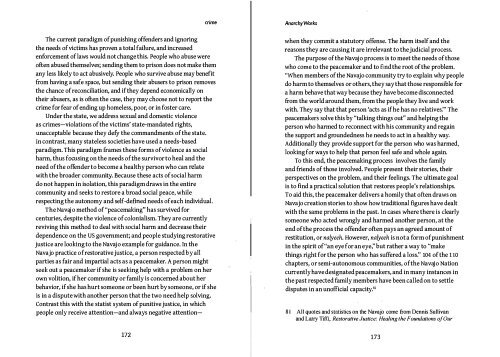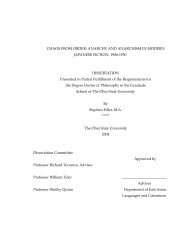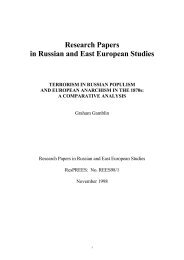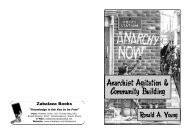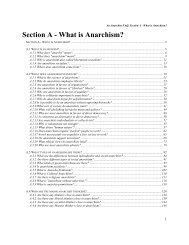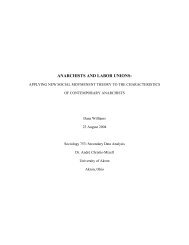Anarchy Works.pdf - Infoshop.org
Anarchy Works.pdf - Infoshop.org
Anarchy Works.pdf - Infoshop.org
You also want an ePaper? Increase the reach of your titles
YUMPU automatically turns print PDFs into web optimized ePapers that Google loves.
crime<br />
<strong>Anarchy</strong> <strong>Works</strong><br />
The current paradigm of punishing offenders and ignoring<br />
the needs of victims has proven a total failure, and increased<br />
enforcement of laws would not change this. People who abuse were<br />
often abused themselves; sending them to prison does not make them<br />
any less likely to act abusively. People who survive abuse may benefit<br />
from having a safe space, but sending their abusers to prison removes<br />
the chance of reconciliation, and if they depend economically on<br />
their abusers, as is often the case, they may choose not to report the<br />
crime for fear of ending up homeless, poor, or in foster care.<br />
Under the state, we address sexual and domestic violence<br />
as crimes-violations of the victims' state-mandated rights,<br />
unacceptable because they defy the commandments of the state.<br />
In contrast, many stateless societies have used a needs-based<br />
paradigm. This paradigm frames these forms of violence as social<br />
harm, thus fOCUSing on the needs of the survivor to heal and the<br />
need of the offender to become a healthy person who can relate<br />
with the broader community. Because these acts of social harm<br />
do not happen in isolation, this paradigm draws in the entire<br />
community and seeks to restore a broad social peace, while<br />
respecting the autonomy and self-dermed needs of each individual.<br />
The Navajo method of "peacemaking" has survived for<br />
centuries, despite the violence of colonialism. They are currently<br />
reviving this method to deal with social harm and decrease their<br />
dependence on the us government; and people studying restorative<br />
justice are looking to the Navajo example for guidance. In the<br />
Navajo practice of restorative justice, a person respected by all<br />
parties as fair and impartial acts as a peacemaker. A person might<br />
seek out a peacemaker if she is seeking help with a problem on her<br />
own volition, if her community or family is concerned about her<br />
behavior, if she has hurt someone or been hurt by someone, or if she<br />
is in a dispute with another person that the two need help solving.<br />
Contrast this with the statist system of punitive justice, in which<br />
people only receive attention-and always negative attention-<br />
when they commit a statutory offense. The harm itself and the<br />
reasons they are causing it are irrelevant to the judicial process.<br />
The purpose of the Navajo process is to meet the needs of those<br />
who come to the peacemaker and to find the root of the problem.<br />
"When members of the Navajo community try to explain why people<br />
do harm to themselves or others, they say that those responsible for<br />
a harm behave that way because they have become disconnected<br />
from the world around them, from the people they live and work<br />
with. They say that that person 'acts as if he has no relatives:" The<br />
peacemakers solve this by "talking things out" and helping the<br />
person who harmed to reconnect with his community and regain<br />
the support and groundedness he needs to act in a healthy way.<br />
Additionally they provide support for the person who was harmed,<br />
looking for ways to help that person feel safe and whole again.<br />
To this end, the peacemaking process involves the family<br />
and friends of those involved. People present their stories, their<br />
perspectives on the problem, and their feelings. The ultimate goal<br />
is to find a practical solution that restores people's relationships.<br />
To aid this, the peacemaker delivers a homily that often draws on<br />
Navajo creation stories to show how traditional figures have dealt<br />
with the same problems in the past. In cases where there is clearly<br />
someone who acted wrongly and harmed another person, at the<br />
end of the process the offender often pays an agreed amount of<br />
restitution, or nalyeeh. However, nalyeeh is not a form of punishment<br />
in the spirit of "an eye for an eye;' but rather a way to "make<br />
things right for the person who has suffered a loss:' 104 of the 110<br />
chapters, or semi-autonomous communities, of the Navajo Nation<br />
currently have designated peacemakers, and in many instances in<br />
the past respected family members have been called on to settle<br />
disputes in an unofficial capacity.sl<br />
81 All quotes and statistics on the Navajo come from Dennis Sullivan<br />
and Larry Tifft, Restorative Justice: Healing the Foundations of Our<br />
172<br />
173


